Loved for its bouncy, slippery texture and appetising colour, alkaline noodles, aka ramen noodles, can be easily made at home and served in many delicious ways.

Jump to:
What are alkaline noodles
Alkaline noodles (Jian Shui Mian, 碱水面) are basically wheat noodles that contain an alkaline component. Having a distinctively springy and slippery texture, they’re commonly used in Southern Chinese noodle dishes and ramen dishes, aka Japanese noodle soup (BTW this doesn’t refer to the instant ramen in packages).
By adding an alkaline agent to the dough, the noodles gain a more elastic, bouncy texture thus don’t snap easily. Also, they taste smooth and slippery, instead of soggy or starchy, after cooking.
Alkaline noodles may be mistaken for Chinese egg noodles as they also have a yellow tone. But when you bite into them, you’d easily notice the difference: they deliver a hint of alkaline flavour that many find pleasant.
Why homemade
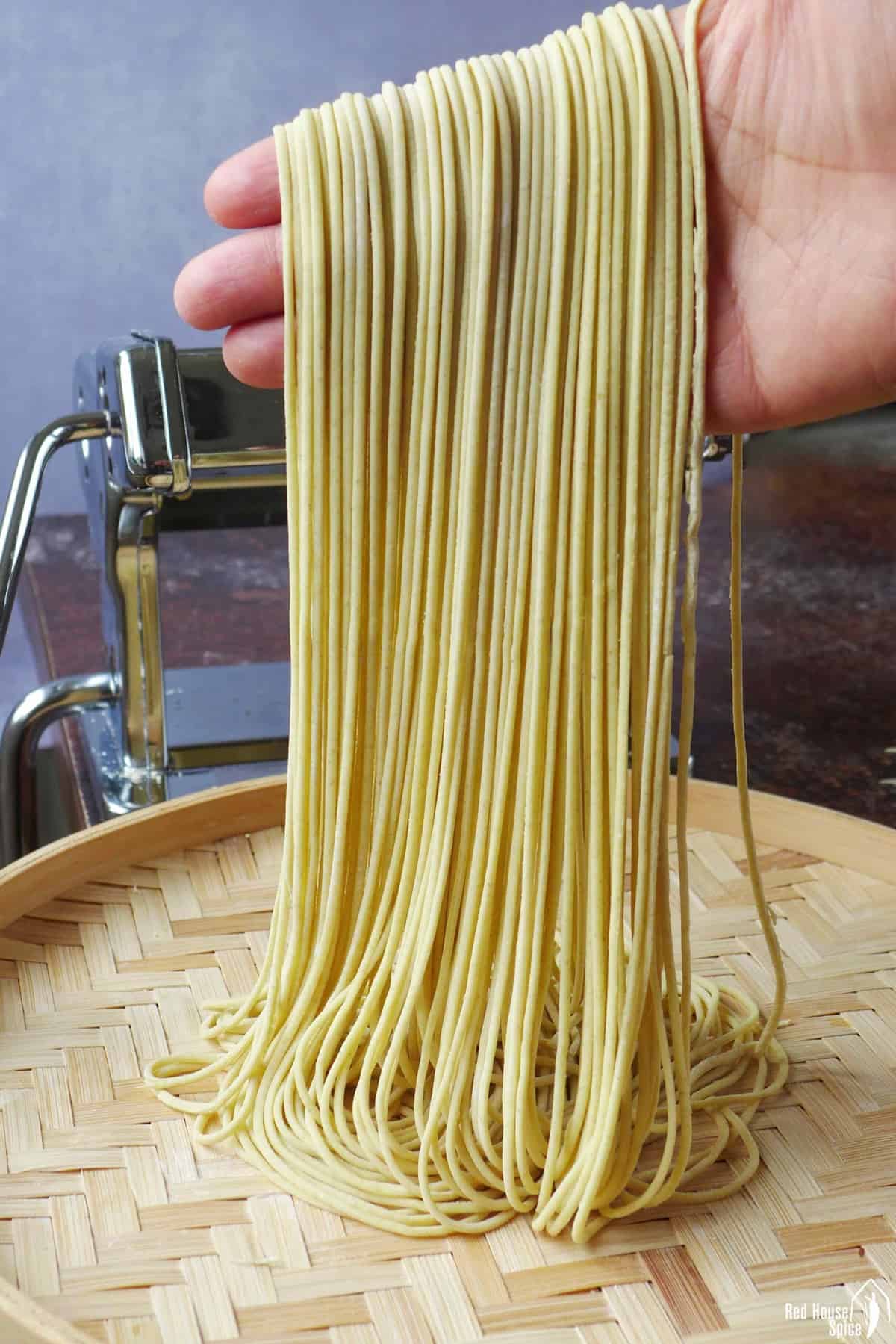
Here are my reasons why you should try this recipe:
- Fresh noodles taste much better than dried ones. And the homemade version is healthier than the commercial ones as there are no hidden preservatives, flavourings, etc.
- It’s so easy to make! Only four ingredients are required. With the aid of a pasta maker, you can make beautiful, uniform-sized noodles with ease.
- Alkaline noodles stay in shape very well and don’t become sticky over time. So you can make them in a big volume and cook them anytime you want.
Ingredients & equipment
To make 4-6 servings of alkaline noodles, you’ll need:
- 500g all-purpose flour, or bread flour
- ½ teaspoon salt
- 210g water
- 1½ teaspoon lye water (Kansui/枧水)
- Cornstarch, for dusting
Lye water & its substitute
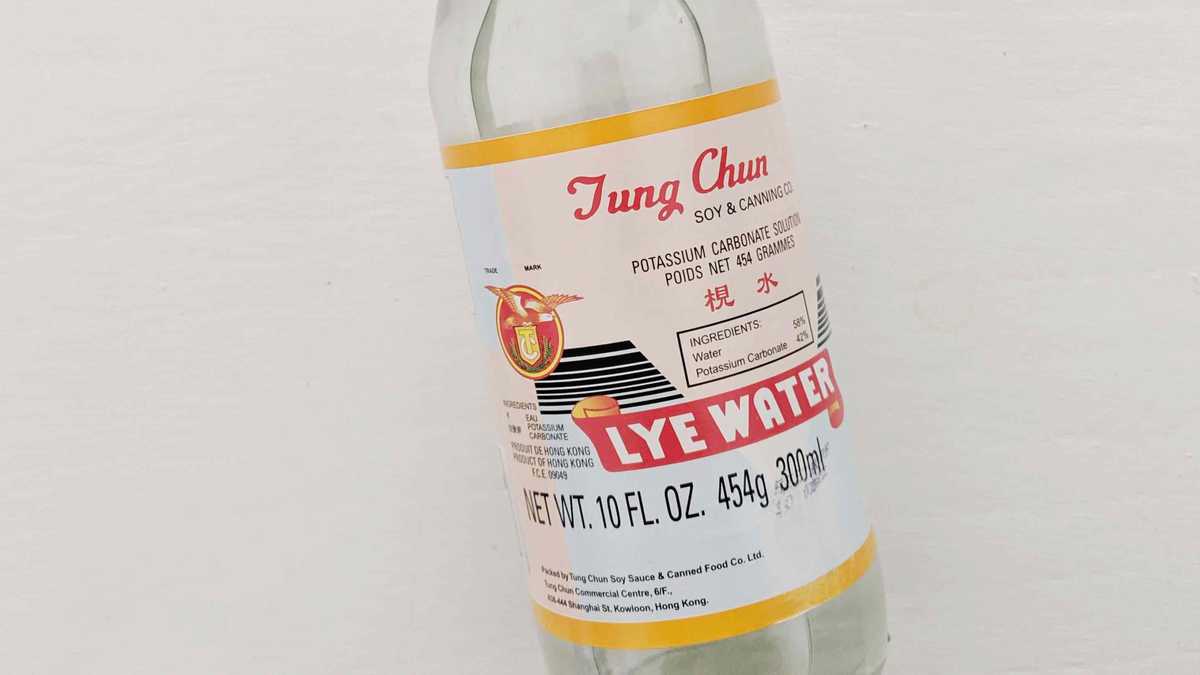
Lye water, also known as Kansui /枧水/雪碱水, is essentially a food grade potassium carbonate solution. You can find it in most Chinese/Asian stores. But making your own is totally achievable.
To produce homemade lye water, you’ll need to bake the baking soda in the oven then mix it with water. I’ve shared the detailed instructions in a separate blog post “Lye Water and Its Homemade Substitute”.
The quantity of lye water used in this recipe can be slightly reduced based on your own preference. If you find the yellow colour or the alkaline taste is too strong, try 1 teaspoon instead. Be sure not to increase its quantity as this would cause an unpleasant bitter taste.
You need a pasta maker
Unlike Chinese hand-rolled noodles (手擀面), the dough for alkaline noodles is much firmer and drier. So you’d need the aid of a pasta maker. I used a traditional manual machine for this recipe. If you have an electric pasta maker which mixes the dough and produces the noodles automatically, I suggest you reduce the water to 195g.
A note on measurements
I like using weight measurements for dough recipes as it produces the most reliable result. If you need to use cups instead, here is how to convert:
- All-purpose flour: 500g equals about 4 cups (The flour needs to be sifted before spooning into the cup then levelled with a knife).
- Water: 210g equals about 1 cup minus 2 tbsp
Make the dough
To evenly distribute the lye water, mix it with water first then gradually pour into the mixture of flour and salt. During this process, stir the flour constantly with chopsticks to make sure everything is fully incorporated.
Use your hand to combine and form a dough. Don’t be disheartened if you find it difficult and please resist the temptation to add more water. The dough is supposed to be on the dry side. It doesn’t need to be smooth. It’s fine as long as everything is pressed into a single mass with no loose flour left aside.
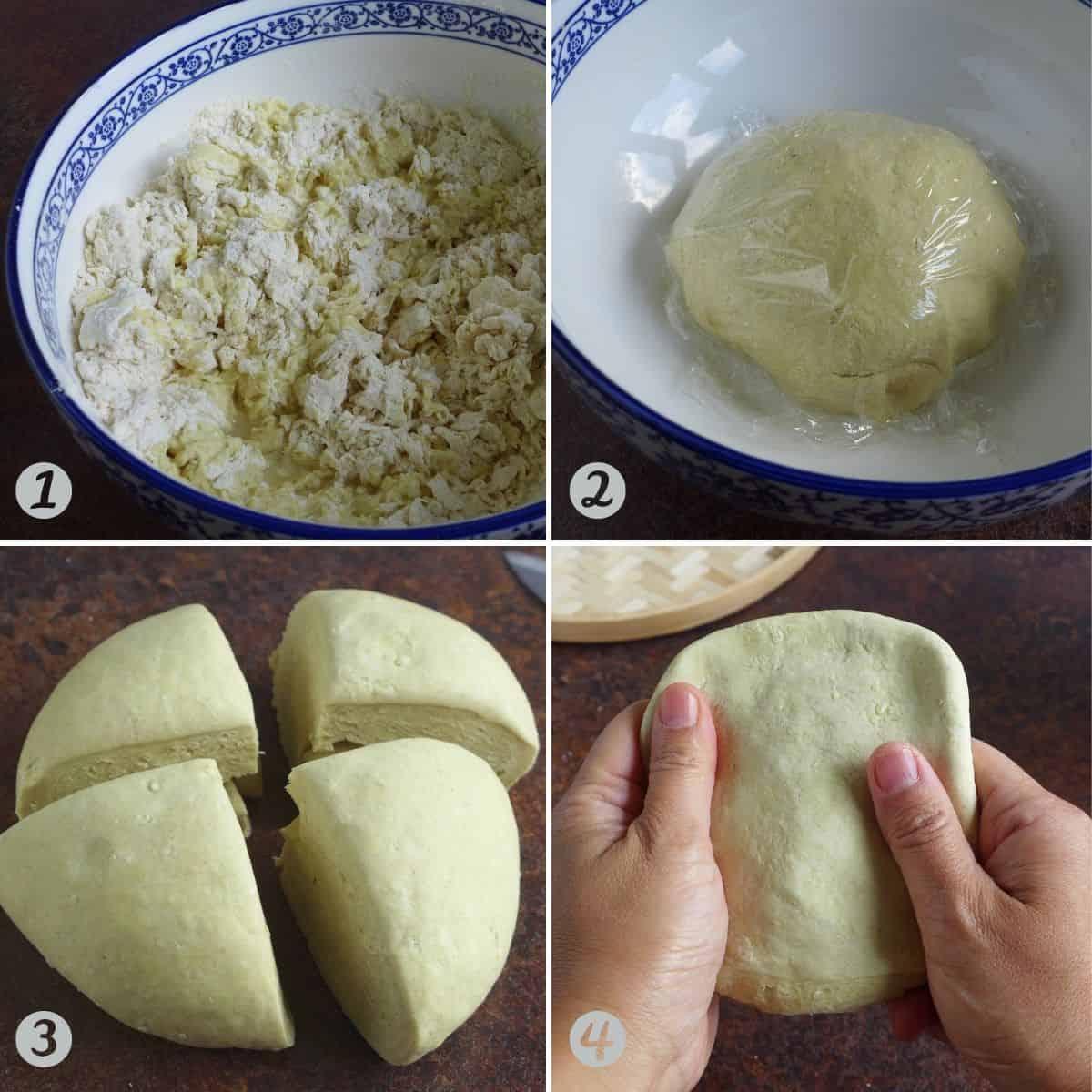
Cover the dough tightly with plastic wrap (cling film) or a damp towel. Leave to rest at room temperature for 1 hour. During this time, the flour will absorb water further so the dough will become less crumbly and easier to work with.
After resting, knead the dough again for 1-2 mins. Don’t worry if it’s still not perfectly smooth. then move on to the next step.
Divide the dough into four portions. Use your hands or a rolling pin to flatten one piece of dough (cover the rest to prevent drying) until it’s thin enough to go through your pasta maker on the widest setting.
Roll the dough sheet
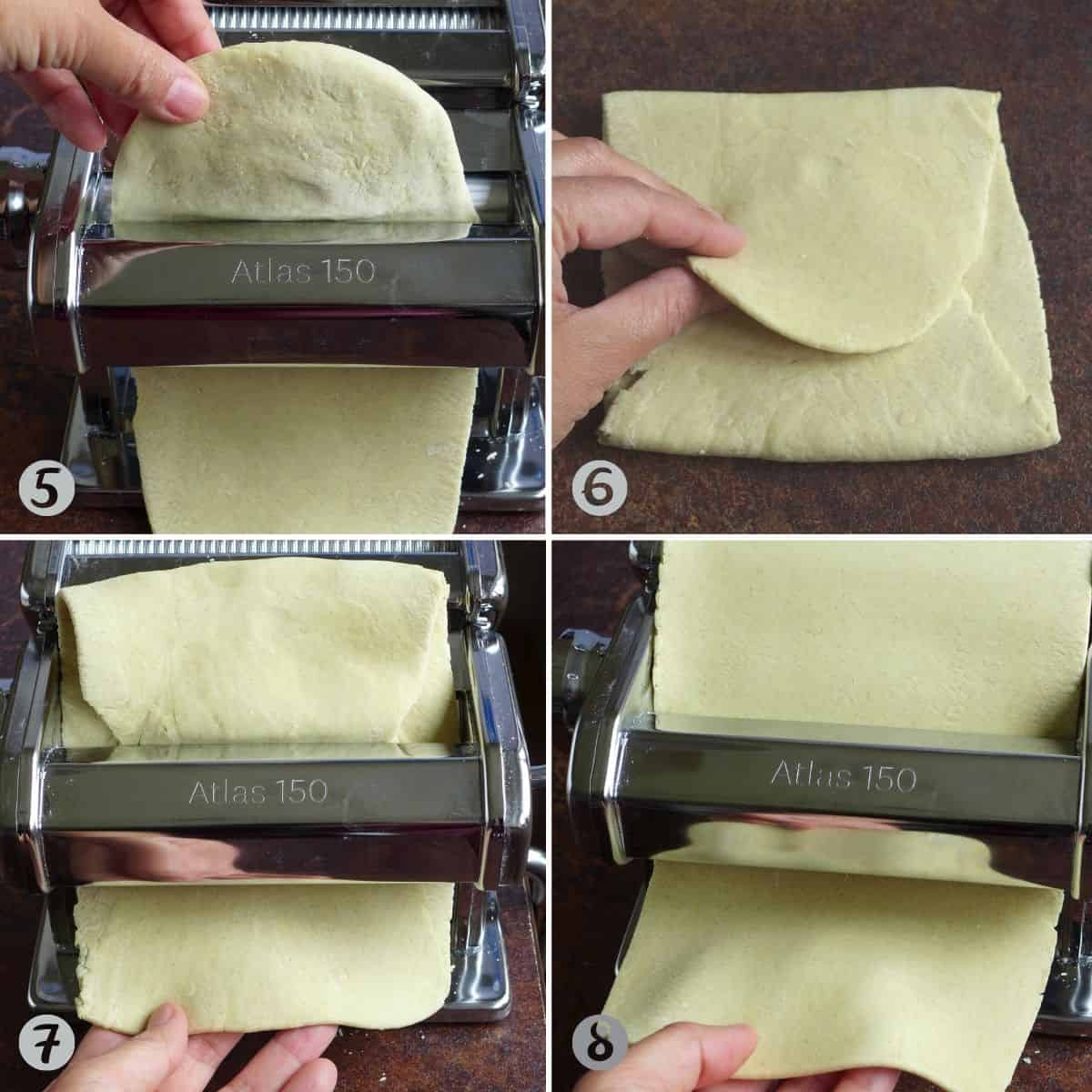
Feed it through the machine. Then fold the dough lengthway and repeat the procedure for another couple of times.
Turn the machine to the next setting. Pass the dough through twice. Then repeat the process while turning the setting one number up at a time until the dough reaches the desired thickness.
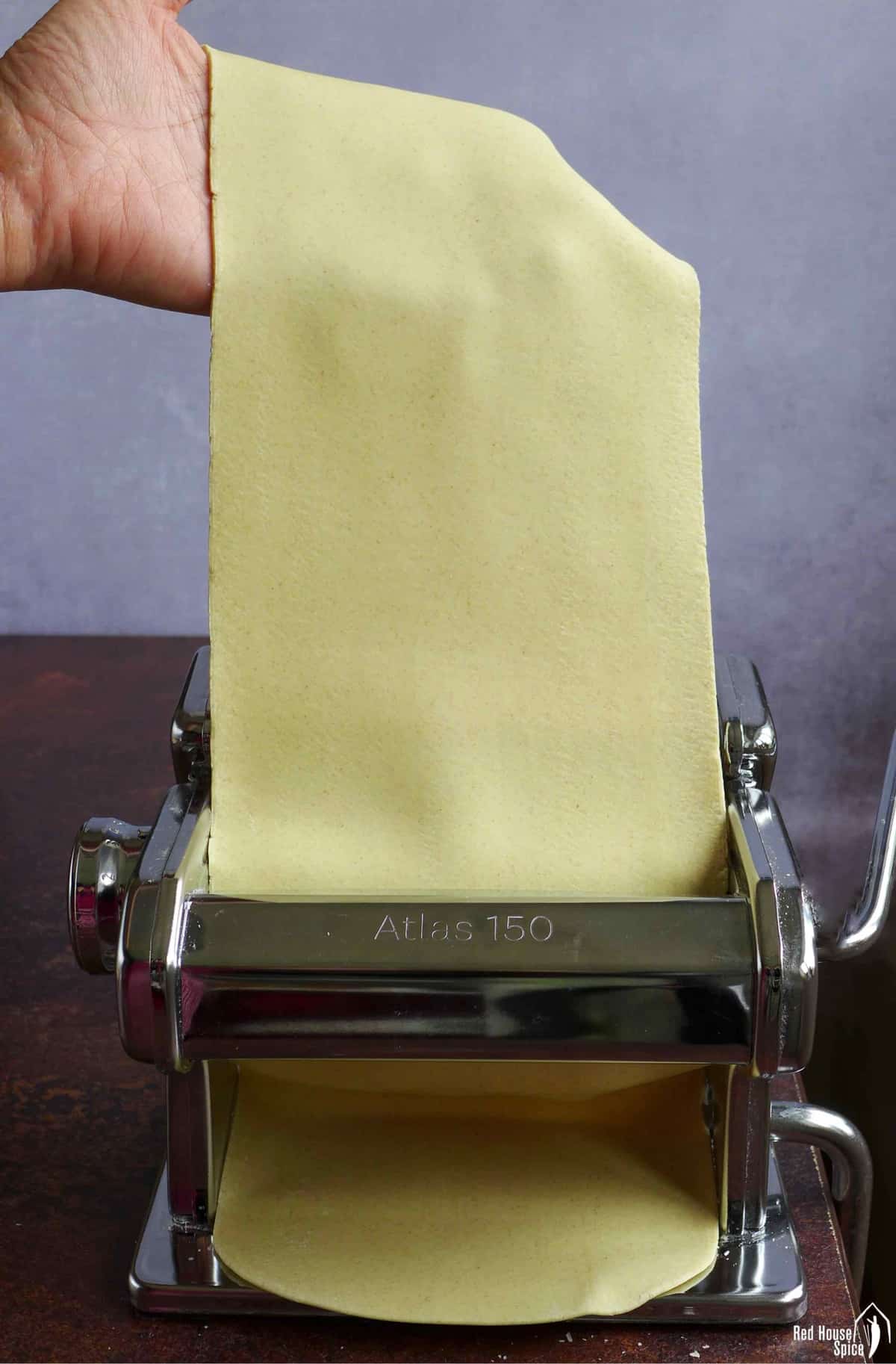
My pasta maker has 10 settings (from 0 to 9). I find No. 3 (2.4mm) or No. 4 (1.8mm) produces the ideal thickness for medium-sized round noodles.
Cut the noodles

Dust the dough sheet with a thin layer of corn starch (or other types of starch) to prevent the noodle strands from sticking.
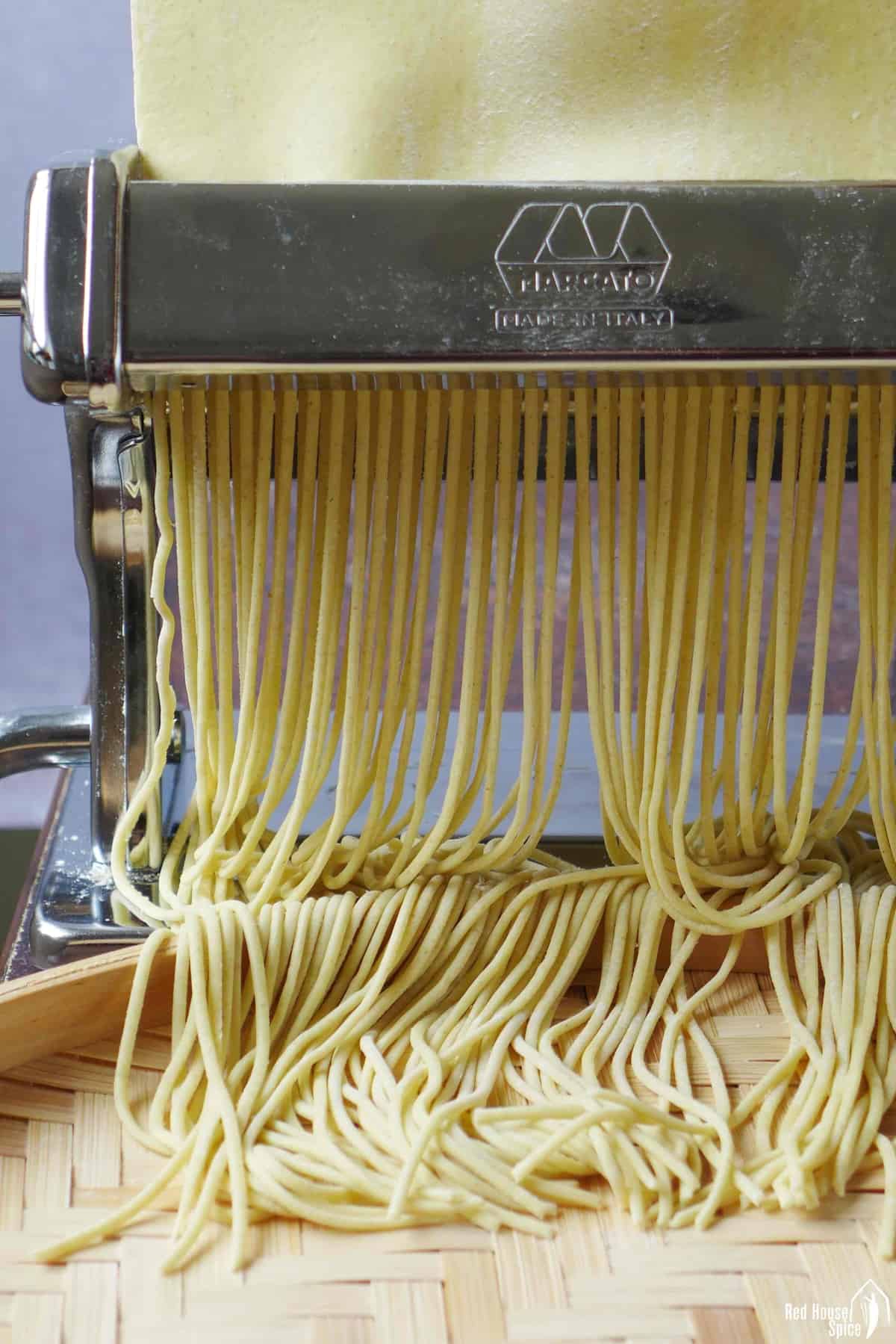
Pass the dough sheet through a cutting attachment to produce noodles ( I use a spaghetti cutter).
Cook the noodles
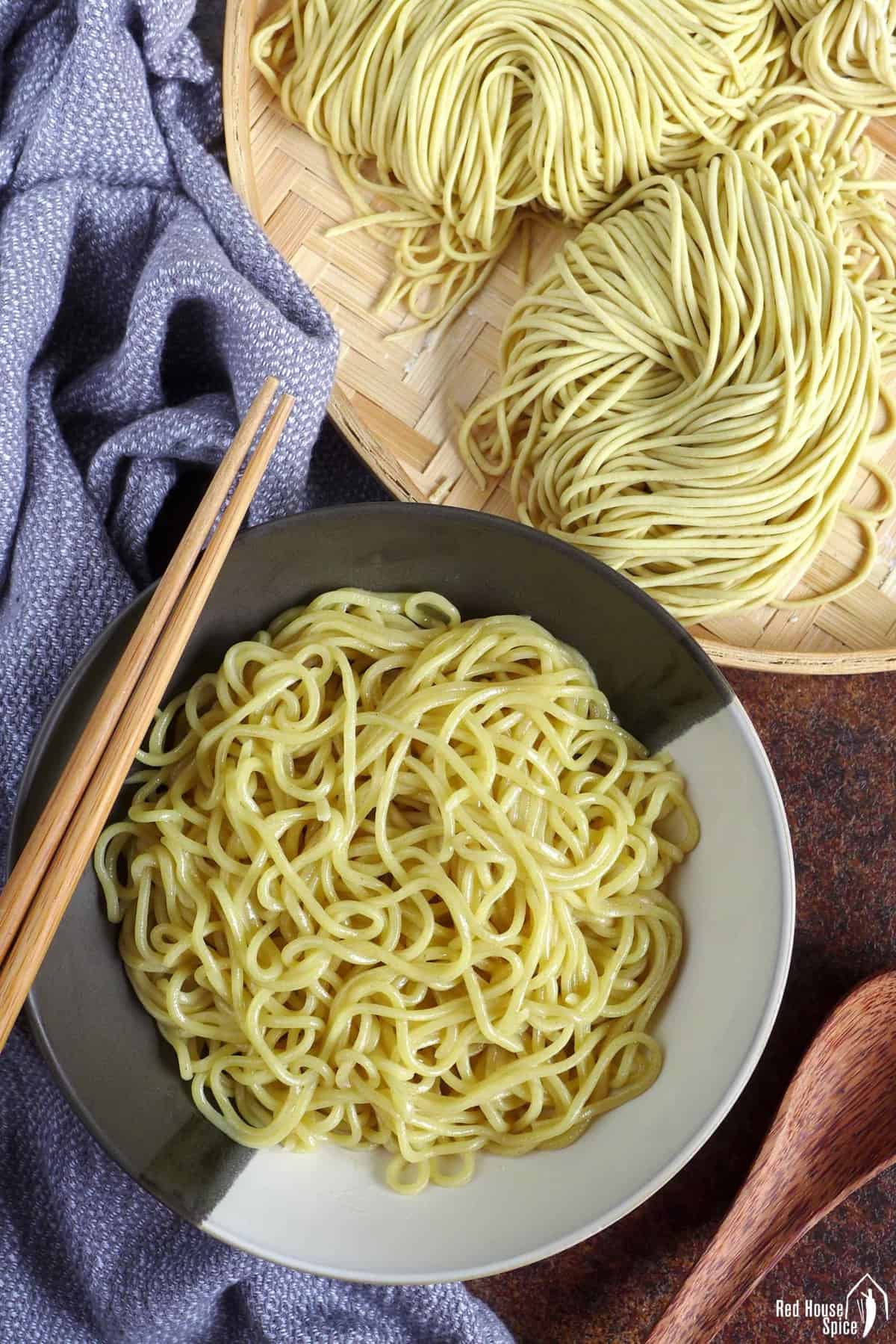
Bring a large pot of water to a full boil. Add the noodles. Once the water comes back to boil, cook for a further 1-2 mins. Taste one strand to check the doneness (Do not overcook).
Rinse the noodles under running water for a few seconds then drain well. Serve with a sauce, toppings or in a soup (if serving as a cold dish, rinse until cooled).
Serving ideas
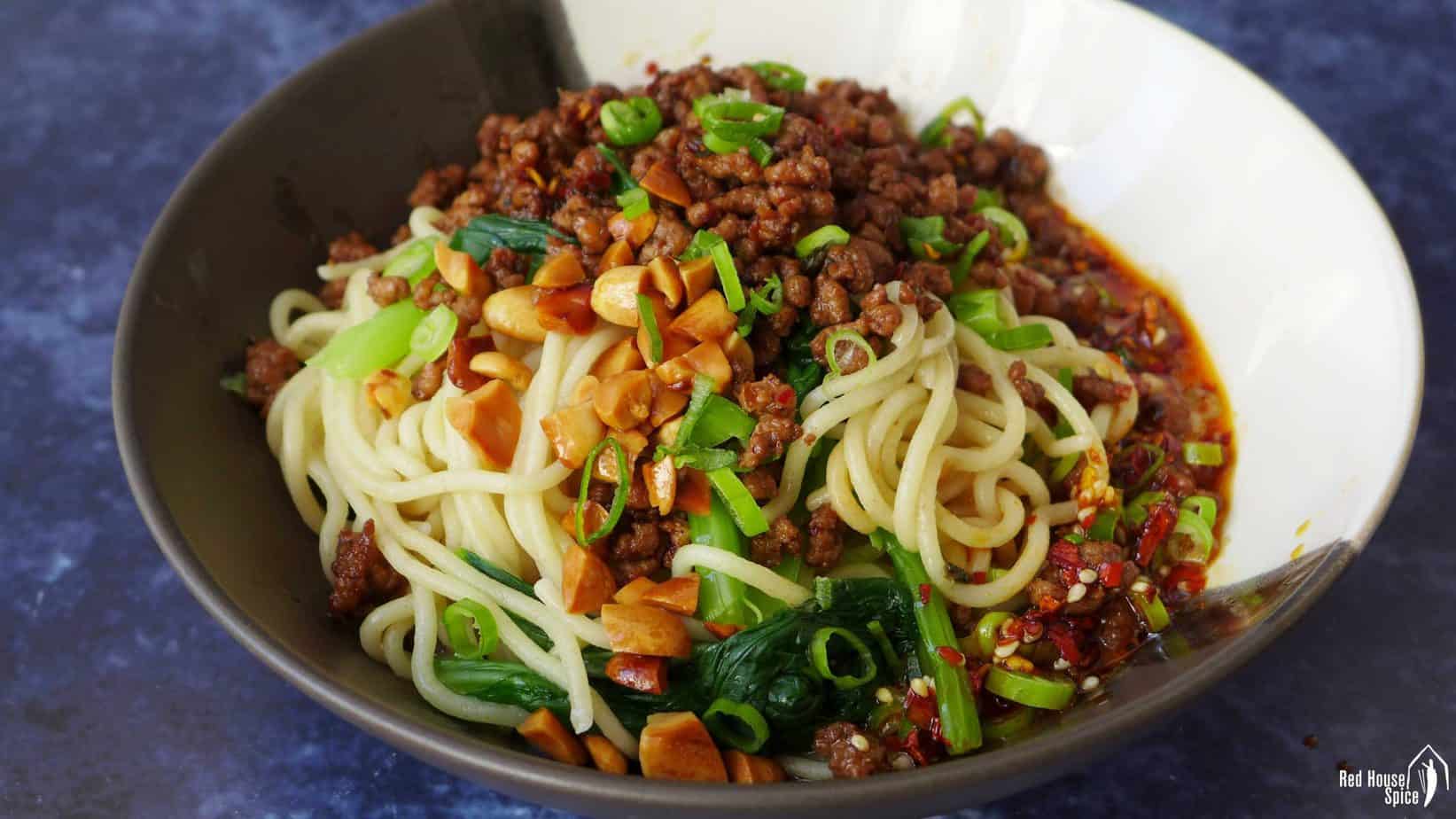
There are many delicious ways to serve alkaline noodles. Try the following:
- Dan Dan Noodles (担担面) and Chongqing Noodles (重庆小面) are popular Chinese street foods that stand out for their scrumptious toppings and sauces.
- Hot Dry Noodles (热干面) and Scallion Oil Noodles (葱油面) make great breakfast choices as they can be put together very easily.
- Chinese Sesame Noodles and Sichuan Style Cold Noodles (凉面) are refreshing cold dishes ideal for warm days.
- Lanzhou Beef Noodles Soup (兰州牛肉面) is usually served with hand-pulled noodles, but these machine-made alkaline noodles work perfectly too.
Make ahead & storage
Compared to other types of fresh noodles, one advantage of alkaline noodles/ramen is that they stay in shape for quite a long time. That is to say, the noodle strands won’t stick to each other and turn into a sticky mess.
So it’s a great idea to make them in big batches for later use. My recipe makes 4-6 servings (depending on your appetite). You can simply increase the quantity of the ingredients proportionally.

Divide uncooked noodles in portions then seal in bags/containers. You can store them in the fridge for up to 5 days, or in the freezer for 3 months.
Cook the noodles following the same instructions explained above. If frozen, they can be boiled straight away without defrosting.
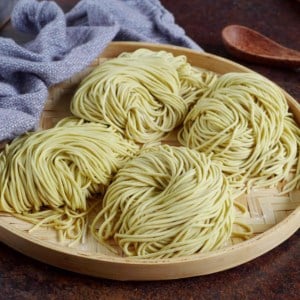
Homemade Alkaline Noodles/Ramen Noodles (碱水面)
Ingredients
- 500 g all-purpose flour
- ½ teaspoon salt
- 210 g water - at room temperature
- 1½ teaspoon lye water (Kansui) - see note 1 for substitute
- Cornstarch - for dusting
Instructions
Make the dough
- Add flour and salt to a mixing bowl. Mix water with lye water then pour into the flour gradually. Stir the flour constantly with chopsticks to evenly distribute the liquid.
- Use your hand to bring the lumps together to form a rough-looking dough. As this dough is on the dry side, this process may take some time to finish. You don’t need to make it smooth. It’s fine as long as everything is combined into one piece.
Rest the dough
- Cover the dough with plastic wrap/cling film or a damp cloth. Leave to rest at room temperature for 1 hour.
- Knead the dough for 1-2 mins to make it smoother (Don’t worry if it’s not perfectly smooth). Then divide into four portions.
Roll the dough sheet
- Use your hands or a rolling pin to flatten one piece of dough (cover the rest to prevent drying) until it’s thin enough to go through your pasta maker on the widest setting.
- Feed it through the machine. Then fold the dough lengthway and repeat the procedure another couple of times.
- Reduce the thickness setting. Pass the dough through twice. Then repeat the process while reducing the setting one number up at a time until the dough reaches the desired thickness. My pasta maker has settings from 0 to 9, I usually stop at No. 3 (2.4mm) or No. 4 (1.8mm).
Cut the noodles
- Dust the dough sheet with a thin layer of corn starch (or other types of starch) to prevent the noodle strands from sticking.
- Pass the dough sheet through a cutting attachment (I use a spaghetti cutter) to produce noodles. At about halfway through the process, use your hand to catch the noodles.
Cook the noodles
- Bring a large pot of water to a full boil. Add the noodles. Once the water comes back to boil, cook for a further 1-2 mins. Taste one strand to check the doneness (Do not overcook).
- Rinse the noodles under running water for a few seconds then drain well. Serve with a sauce, toppings or in a soup (if serving as a cold dish, rinse until cooled).
Store the noodles
- Place uncooked noodles in sealed bags/containers. Store in the fridge for up to 5 days, or in the freezer for 3 months.
- Cook the usual way. No need to defrost if frozen.
Video
NOTES
NUTRITION
NUTRITION DISCLOSURE: Nutritional information on this website is provided as a courtesy to readers. It should be considered estimates. Please use your own brand nutritional values or your preferred nutrition calculator to double check against our estimates.


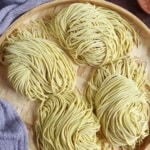
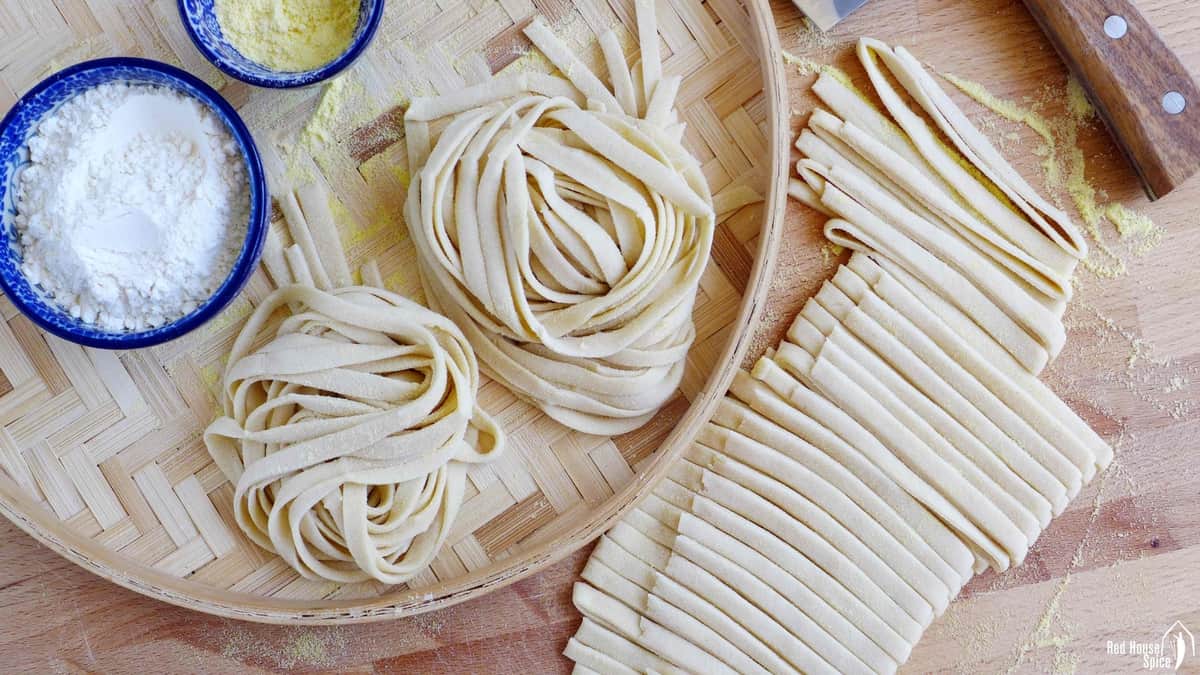
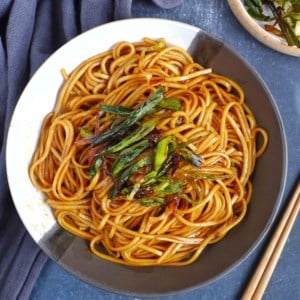
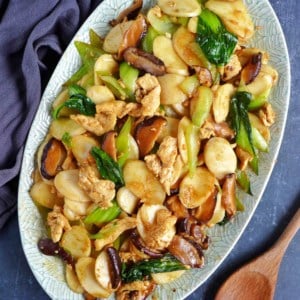

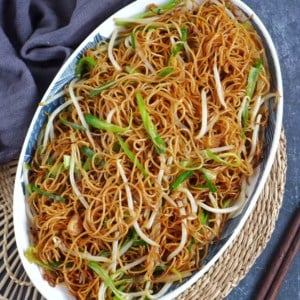
I love that your recipe show use of lye water which is pretty easy to find at a good Asian grocery.
The other thing that frustrates me is all the recipes that tell you how to make a substitute by baking baking soda (sodium bicarbonate).
Laundry soda from Arm and Hammer is already done and food safe why not just use laundry soda instead to baking soda? It’s sodium carbonate! The same thing one is trying to make with baking soda (sodium bicarbonate).
I don’t understand why folks keep trying to make lye water from sodium bicarbonate when sodium carbonate is already available for YEARS.
JMHO
Raymond
Can I use baked baking soda in place of the lye water? What would the amount be? Thank you.
My blog post on Lye Water & Its Homemade Substitute explains how to use baked baking soda to make a solution to replace lye water.
I made this today following your recipe using pizza flour and my kitchenaid pasta roller. My family loved it. The texture was great. Thank you for sharing.
My pleasure to share. Very happy to hear you and your family enjoyed the noodles.
Can I add eggs for flavor?
Yes you can. In this case, you’d need to adjust the water quantity accordingly.
Thank you for sharing this recipe. How do I modify this to make shrimp egg noodles 虾子面 or conpoy noodles.
I haven’t tried making shrimp roe noodles or dried scallop noodles from scratch. I’m afraid I can’t help you with this topic.
I see you say you make 4-6 servings. Do you perhaps know how much each serving weighs
If dividing the uncooked noodles into 4 servings, each serving would weight about 180g/6.3oz.
I have tried other ramen noodles…..but your recipe is fabulous. Followed your ingredients….but used my Philips Pasta Maker. So easy. The difference was lye water (Kansui) which I had ordered on Amazon. No question Kansui put it over the top….texture and taste. Thank you so very much!!!!!
You’re welcome Sandra! So happy you find my recipe helpful. Wish you a fun time making your own noodles!
Made these tonight, first time, they were so good – thanks for the recipe! Had them in khao soy and taken aback by how much fresh homemade ramen noodles elevated a dish I have cooked plenty with store bought noodles.
Yes Murray! Homemade noodles can indeed take a dish to the next level. Glad you enjoyed my recipe.
Hi Wei,
Thank you for this recipe! I have all the ingredients and will be making it soon. 2 Qs, can i make the dough in a stand-mixer or do you think it will be too dry for the machine? 2nd – can i stir fry these noodles after boiling them as per your instructions? Look forward to hearing from you! 🙂
You’re right that this dough is a bit too dry to be made in a stand mixer. They can surely be stir-fried. Boil them the usual way but a little undercooked. Then rinse them under cold water and drain well before stir-frying.